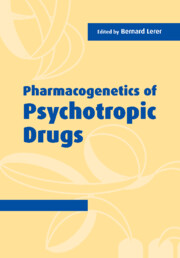Book contents
- Frontmatter
- Contents
- List of contributors
- Part I Introduction
- Part II Clinical background and research design
- Part III Molecular background
- Part IV Pharmacokinetics
- Part V Specific psychotropic drugs and disorders
- 10 Clozapine response and genetic variation in neurotransmitter receptor targets
- 11 Genetic factors underlying drug-induced tardive dyskinesia
- 12 Functional gene-linked polymorphic regions in pharmacogenetics
- 13 Alternative phenotypes and the pharmacogenetics of mood and anxiety disorders
- 14 Pharmacogenetics of anxiolytic drugs and the GABA–benzodiazepine receptor complex
- 15 Genetic factors and long-term prophylaxis in bipolar disorder
- 16 Genetic influences on responsiveness to anticonvulsant drugs
- 17 Apolipoprotein E as a marker in the treatment of Alzheimer's disease
- 18 Genetic variation and drug dependence risk factors
- Part VI Pharmacogenetics and brain imaging
- Part VII Industry perspectives
- Index
18 - Genetic variation and drug dependence risk factors
from Part V - Specific psychotropic drugs and disorders
Published online by Cambridge University Press: 20 August 2009
- Frontmatter
- Contents
- List of contributors
- Part I Introduction
- Part II Clinical background and research design
- Part III Molecular background
- Part IV Pharmacokinetics
- Part V Specific psychotropic drugs and disorders
- 10 Clozapine response and genetic variation in neurotransmitter receptor targets
- 11 Genetic factors underlying drug-induced tardive dyskinesia
- 12 Functional gene-linked polymorphic regions in pharmacogenetics
- 13 Alternative phenotypes and the pharmacogenetics of mood and anxiety disorders
- 14 Pharmacogenetics of anxiolytic drugs and the GABA–benzodiazepine receptor complex
- 15 Genetic factors and long-term prophylaxis in bipolar disorder
- 16 Genetic influences on responsiveness to anticonvulsant drugs
- 17 Apolipoprotein E as a marker in the treatment of Alzheimer's disease
- 18 Genetic variation and drug dependence risk factors
- Part VI Pharmacogenetics and brain imaging
- Part VII Industry perspectives
- Index
Summary
OVERVIEW
This chapter discusses pharmacogenetics in the context of substance abuse and dependence. Owing to the nature of substance-dependence disorders – an exogenous substance is ingested – there is virtually always potential for direct interaction with pharmacogenetic factors, many of which would be expected to be specific to the substance of abuse. Several well-understood examples of such factors are discussed. These issues are placed in the context of identifying and understanding broader genetic risk factors for substance dependence, and of guiding development of pharmacological treatments, both for all patients abusing a given class of substance, and for individual patients based on their specific biochemical make-up as predicted by genetic polymorphism.
Introduction
Genetic factors are important contributors to risk for substance dependence. Some are specific to the substance (e.g., resulting in different euphoric effects by individual), and some are more general (e.g., personality features – novelty seeking, anti-social personality, and so on – which may influence exposure to substances or the transition from substance use to dependence). While the factors that might be mediated by personality and behavior can be conceptualized as analogous to genetic risk factors for other classes of psychiatric disorder, those that are specific to the abused substance could reflect a different set of mechanisms involving genetic variability in receptor–ligand interaction or metabolism of the substance. This can be illustrated by considering two hypothetical limiting cases.
Keywords
- Type
- Chapter
- Information
- Pharmacogenetics of Psychotropic Drugs , pp. 372 - 388Publisher: Cambridge University PressPrint publication year: 2002

